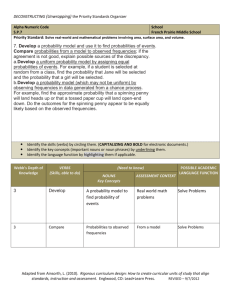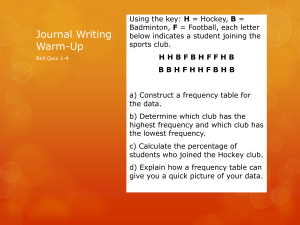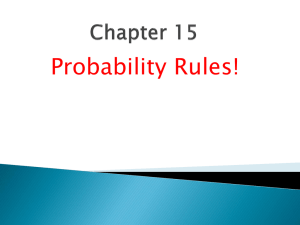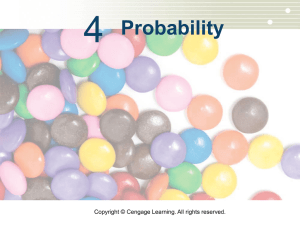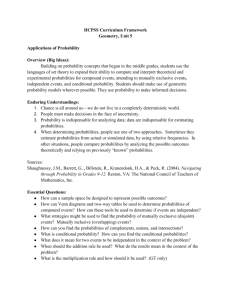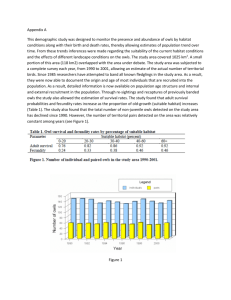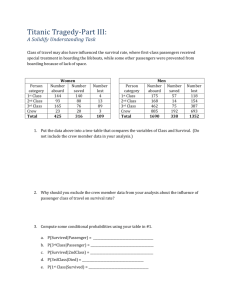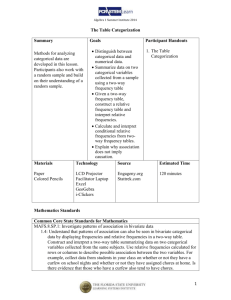StatsDay2015
advertisement
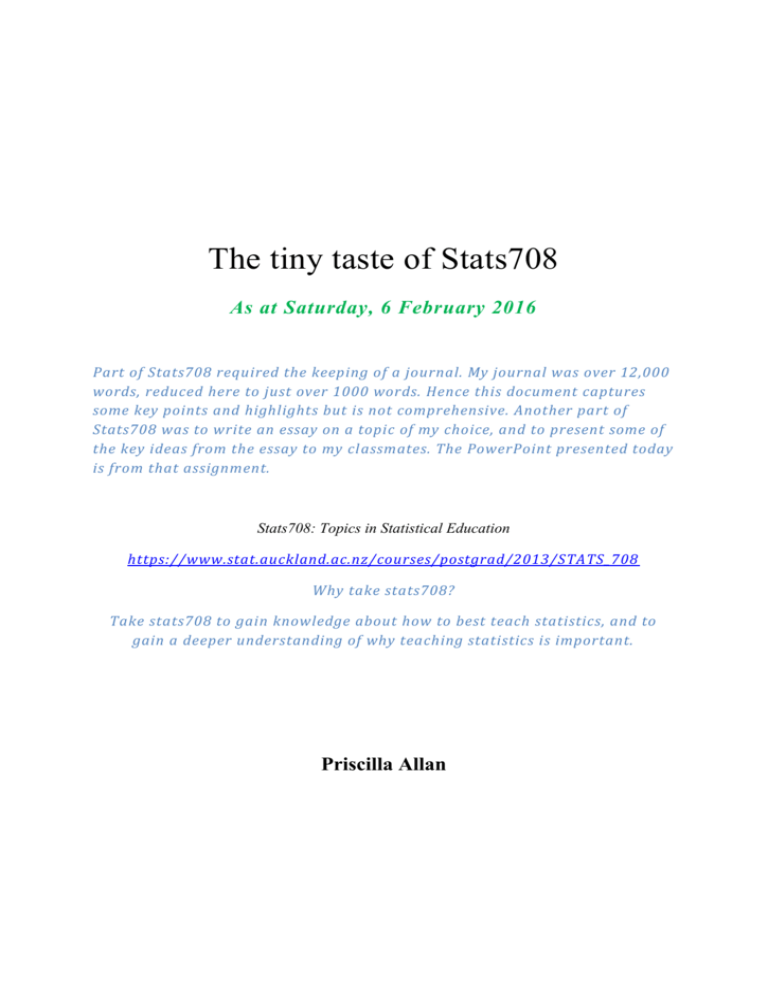
The tiny taste of Stats708 As at Saturday, 6 February 2016 Part of Stats708 required the keeping of a journal. My journal was over 12,000 words, reduced here to just over 1000 words. Hence this document captures some key points and highlights but is not comprehensive. Another part of Stats708 was to write an essay on a topic of my choice, and to present some of the key ideas from the essay to my cl assmates. The PowerPoint presented today is from that assignment. Stats708: Topics in Statistical Education https://www.stat.auckland.ac.nz/courses/postgrad/2013/STATS_708 Why take stats708? Take stats708 to gain knowledge about how to best teach statistics, and to gain a deeper understanding of why teaching statistics is important. Priscilla Allan Table of Contents Overview ......................................................................................................................................... 1 Planning........................................................................................................................................... 1 o Teaching through a context rather than teaching concepts....................................................... 1 o Hands on activities (first) ............................................................................................................ 1 o Real world connections. .............................................................................................................. 2 o Probabilistic modelling links the real world. ............................................................................... 2 o Pachinkogram ............................................................................................................................. 2 o Equally likely outcome bias ......................................................................................................... 2 o Strategic use of Pip Arnold resources. ........................................................................................ 2 o Follow Anna-Marie Martins blog about teaching. ...................................................................... 2 o Passion found through deeper understanding. .......................................................................... 2 Probability and statistics concepts are real world and tricky. ........................................................ 3 o Real world ignorance .................................................................................................................. 3 o Regression to the mean .............................................................................................................. 3 o Framing questions....................................................................................................................... 3 o A misleading real world .............................................................................................................. 3 o Natural frequencies easier than conditional probabilities. ........................................................ 4 3 types of Randomisation ............................................................................................................... 5 o Simulations for stochastic modelling .......................................................................................... 5 o Bootstrapping for sampling ........................................................................................................ 5 o Random re-grouping for experiments ........................................................................................ 5 ii Overview We have a pretty good idea now of what we are teaching. But what is the best way to teach it? The next step is to refine our pedagogical practises and trial different ways of introducing content. Planning Get the census at school resources embedded into planning at the department level. Probability concepts take years to learn, not months, so long term, school wide planning is required. We planned by course, but I wonder about the progression from the student perspective over the years. The careful progression of lessons builds concepts through activities. I was expecting too much from my students. When students look at graphs they are not seeing what I see in spite of my best efforts; hands on tasks are required in order for students to comprehend what the computer is doing, and to understand the concepts. o Teaching through a context rather than teaching concepts In mathematics we often teach a concept and then we apply the concept. In statistics concepts cannot be taught without a context, they must be taught through a context. o Hands on activities (first) Tinkerplots scaffolds the students, so they can connect the real world with digital simulation. Simulations are meaningless if they are not connected to the real world. Students invent their own data, which helps them think of data as a whole. Growing samples allows students to see stable features of variable processes. Predicting shapes can encourage a global view and the concept of signal and noise. 1 o Real world connections. Go beyond coins, dice and spinners and connect to the real world. This generation do not play board games as much, as they have technology at their fingertips. Build probability models through computer applications. o Probabilistic modelling links the real world. The SWAMTU model is the PPDAC equivalent for probability modelling. Coming soon and comes from the “real world”. o Pachinkogram The Pachinkogram (M. Pfannkuch, 2014) is on Census at School (CensusAtSchool, 2015a). Frequencies being easier to understand than probabilities; visualizations aid understanding. o Equally likely outcome bias Perhaps the preference for equal probability has everything to do with their exposure to dice, coins and regular spinners. Investigate “pass the pigs” as there is no obvious theoretical model hence frequencies must be used. o Strategic use of Pip Arnold resources. I better understand their purpose to deal with shape and the story behind the data. Building understanding through doing creates a deeper understanding than telling students about concepts which gives superficial understanding. o Follow Anna-Marie Martins blog about teaching. http://teaching.statistics-is-awesome.org/probability-teaching-ideas-usingsimulation-part-1/ now that we have moved beyond survival we need to start thinking about pedagogy. o Passion found through deeper understanding. I have gained lots of stories to share, about doctors, lawyers and risk. Linking statistical literacy and financial literacy could also help student’s motivation. 2 Probability and statistics concepts are real world and tricky. o Real world ignorance Doctors and lawyers do not have a strong grasp on statistical and probability concepts. The way information is presented can make a huge difference to the way people interpret it. The media knows little. People must be taught how to simply problems to enable intuitive understanding. o Regression to the mean Regression to the mean: any outcome with an element of chance involved will naturally vary, and after a particularly good or bad event, a more normal one will tend to follow. Humans tend to look for cause and effect when looking at two sequential data values. Whilst a system change may impact on the mean, the difference between two sequential events is random. o Framing questions Framing questions can cause rational people to give opposite answers as we tend to take risk to avoid loss. I can be tempted to risk in order to avoid loss, but will always take the bird in the hand. This explains why people often keep going down the wrong path, rather than admit they have made a mistake and cut their losses. o A misleading real world Relative risk can be reported in a truthful and simultaneously misleading manner which can have significant negative health implications. We teach the mathematics of certainty, but not as much of the mathematics of uncertainty. Lead-time bias and over diagnosis are not well understood by Doctors, leaving doctors as easy targets for manipulation through misleading statistics. Deception by confusing survival with mortality paints untrue improvements. Early detection of cancer through screening may result in unnecessary treatments which leave the patient with lifelong issues, without increasing the patients’ survival rate. 3 We need to prepare the next generation to understand five year survival rates rather than p-values. Teach students to convert to natural frequencies so they can get a feel for complex conditional probability questions. A chilling piece of evidence was that guilty verdicts in court happen more often when probabilities are used, that are not understood. Only around 15% of lawyers actually understand probabilities. The overall message is to report facts honestly and transparently so that people can make up their own minds. o Natural frequencies easier than conditional probabilities. Natural frequencies are easier to understand than conditional probabilities. Mortality rates are more truthful than 5-year-survival rates. 5 year survival rates are dependent on when screening happens, so do not report anything meaningful in terms of health. Absolute risks are honest, whereas relative risks are meaningless without the absolute risk being transparently reported. 4 3 types of Randomisation o Simulations for stochastic modelling Americans are talking about the curriculum being based on randomisation they are referring to simulations. o Bootstrapping for sampling Bootstrapping is used for sample to population inference. I felt the signal was the population parameter, and the noise was sampling error, when considering inference. o Random re-grouping for experiments Random re-grouping is used to check for causality in experimental data. I felt the signal was the effect of the treatment in an experiment, and the noise was chance. 5
